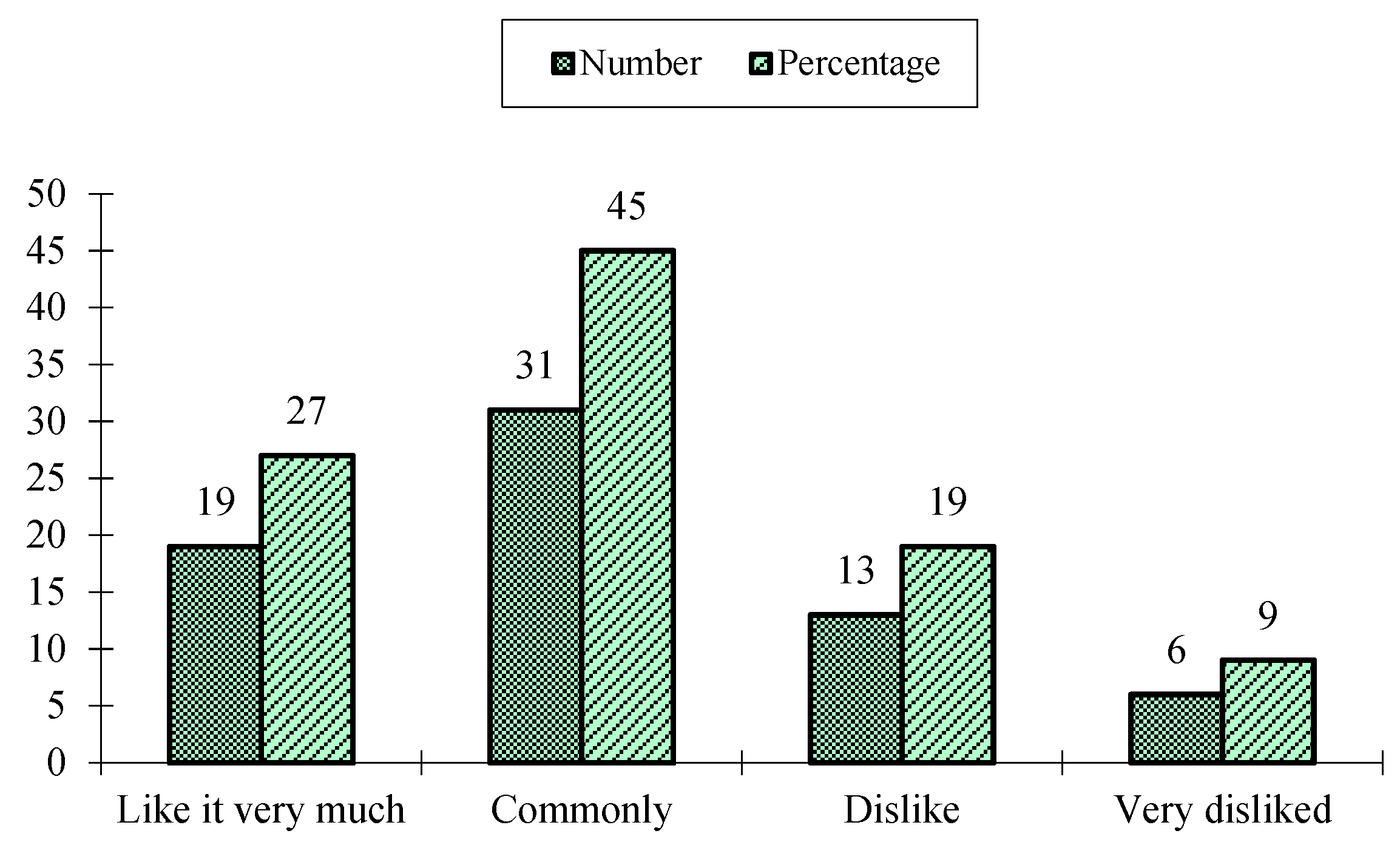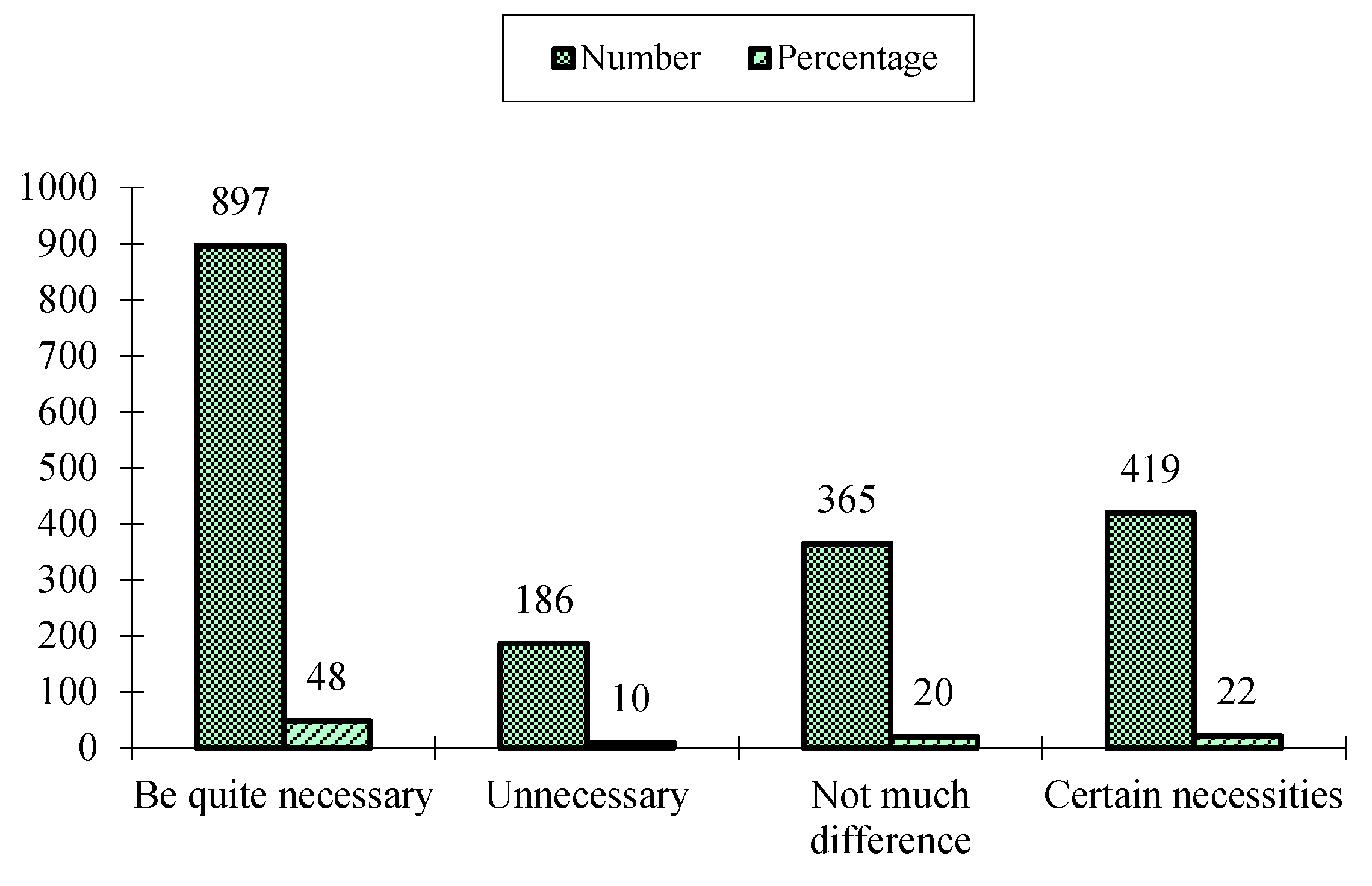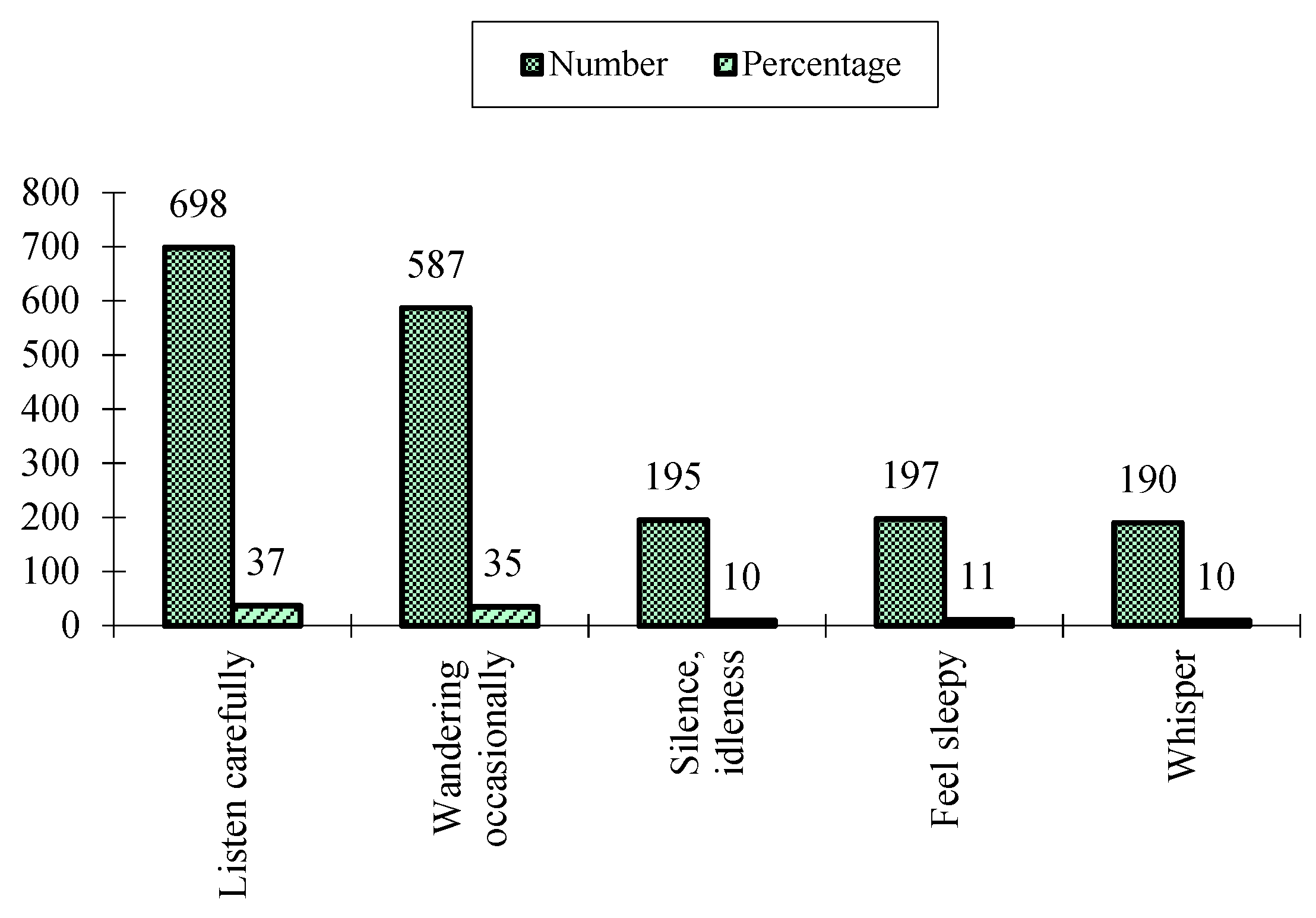Symmetry for Multimedia-Aided Art Teaching Based on the Form of Animation Teaching Organization and Social Network
Abstract
:1. Introduction
2. Literature Review
2.1. Multimedia-Aided Teaching
2.2. Symmetrical Thinking in Multimedia Art Teaching
2.3. Social Network Media
2.4. Art Education
3. Methodology
3.1. Symmetry Thinking in Teaching
3.2. Application of Multimedia Technology in Teaching
3.3. Characteristics of Art Education and Multimedia Teaching
3.4. Survey Object of Multimedia Technology Assisted Art Teaching
4. Results and Discussion
4.1. Application of Multimedia Technology in Art Teaching
4.2. The Status Quo of Teachers Using Multimedia Teaching
4.3. Students’ Views on the Use of Multimedia Teaching
4.4. Effective Strategies for Organizing Art Teaching in Multimedia
5. Conclusions
Funding
Conflicts of Interest
Appendix A. Questionnaire on Multimedia Organizational Teaching of Front-line Teachers
- a lot
- general
- seldom
- never
- less than one year
- about one year
- about two years
- more than two years
- very much
- just so so
- dislike
- hate
- all of them
- some of them
- none of them
- yes
- no
- a little
- decrease the students’ interest instead
- obvious
- general
- not obvious
- the effect is worse.
- poor sound insulation between classrooms
- low grade
- cumbersome operation
- poor management
- homemade
- purchasing
- downloading
- downloading and remanufacturing online
- overdependence on multimedia to dilute teachers’ leading role
- The application ability of multimedia technology is not strong enough
- not conducive to the development of students’ thinking ability
- Some teachers have deviations in their teaching concepts (abuse or non-use)
- Too much information makes students cannot keep up with the speed of lecture, and less students attend the lecture. They copy the courseware after class.
Appendix B. Questionnaire on Multimedia-aided Instruction in Art Classroom
- disagree
- indifferent
- agree
- It’s necessary
- It’s not necessary
- There’s not much difference
- In some courses, it is necessary.
- Multimedia is used to display pictures
- by teachers’ demonstration
- Both of them are easy to accept.
- great change
- a little change
- little change
- no change
- very interesting
- interesting
- just so so
- not interesting
- quite good
- good
- just so so
- not good
- bad
- practice as required by teachers
- play games
- chat on QQ
- watch online movies
- listen carefully
- listen carefully, but occasionally, you are distracted
- stunned, idle
- sleepy
- talk to your deskmate in a low voice.
- quite good
- good
- just so so
- Some courses are good, but some courses are not good.
- poor.
- quite good
- good
- just so so
- not good
- just for fun
- quite good
- good
- just so so
- not good
- poor.
- quite high
- high
- just so so
- low
- poor
- Lessons preparation is not serious
- Sitting position is not proficient in teaching
- Operating skills are not proficient
- Low level of courseware production
- Teachers do not pay attention to students’ reactions, only focus on demonstration courseware most of the time.
- not accustomed to multimedia teaching
- Audio and video influence attention
- It is difficult to grasp teachers’ ideas
- Too much courseware makes it difficult keep up with the speed of lectures
- Multimedia teaching will increase the inertia of teachers and lead to electronic “full house irrigation”
- When using multimedia to teach, we are too busy taking notes to listen to the teacher’s classroom analysis and interact with the teacher, so we can’t give timely feedback.
- The computer often breaks down
- The sound effect is not good
- The projection effect is not good.
- Sound insulation effect is poor, and each classroom affects each other
- other factors
- use standby teaching plan blackboard and give demonstration lectures
- lecturing without a lesson plan
- ask someone to repair or retrieve the courseware before giving lectures
- do not lecture, let students do homework and study by themselves, teacher counseling and answering questions
- no lectures. let students study and do homework by themselves. Teachers leave the classroom.
- Replace the content of courseware with the catalogue of textbooks
- Often replacing class with audio-visual
- Projecting directly from textbooks or handouts
- not using courseware, only using sound reinforcement equipment.
- use courseware with pictures and texts, prominent emphasis and clear organization in class
- use courseware with poor quality to teach
- give priority to multi-media display, less explanation
- use multi-media to teach completely
- Do not use multimedia at all or less. The traditional explanation is mainly carried out.
- It depends on the content of the course and should be combined reasonably.
- Teachers and students have more time to communicate, discuss
- Teachers’ role diversifies
- The media role of multimedia
- Teachers and students do not have more time to communicate, discuss
- Teachers become obstacles to multimedia operators
- multimedia obstacles
- asking teacher through the internet,
- finding teacher’s face-to-face answer
- asking classmate through the internet
- finding information through the internet
References
- Schank, R.C.; Korcuska, M.; Jona, M. Multimedia Applications for Education and Training: Revolution or Red Herring? ACM Comput. Surv. 2016, 27, 633–635. [Google Scholar] [CrossRef]
- Abreu, R.; Dos Santos, J. Using abstract anchors to aid the development of multimedia applications with sensory effects. In Proceedings of the 2017 ACM Symposium on Document Engineering, Using Abstract Anchors to Aid The Development of Multimedia Applications With Sensory Effects, Valletta, Malta, 4–7 September 2017; Volume 2, pp. 211–218. [Google Scholar]
- Shuja, J.; Gani, A.; ur Rehman, M.H.; Ahmed, E.; Madani, S.A.; Khan, M.K.; Ko, K. Towards native code offloading based MCC frameworks for multimedia applications: A survey. J. Netw. Comput. Appl. 2016, 75, 335–354. [Google Scholar] [CrossRef]
- Das, A.; Kumar, A.; Veeravalli, B. Reliability and Energy-Aware Mapping and Scheduling of Multimedia Applications on Multiprocessor Systems. IEEE Trans. Parallel Distrib. Syst. 2016, 27, 869–884. [Google Scholar] [CrossRef] [Green Version]
- Peddi, S.V.B.; Kuhad, P.; Yassine, A.; Pouladzadeh, P.; Shirmohammadi, S.; Shirehjini, A.A.N. An intelligent cloud-based data processing broker for mobile e-health multimedia applications. Future Gener. Comput. Syst. 2017, 66, 71–86. [Google Scholar] [CrossRef]
- Cremonesi, P.; Elahi, M.; Garzotto, F. User interface patterns in recommendation-empowered content intensive multimedia applications. Multimed. Tools Appl. 2017, 76, 1–35. [Google Scholar] [CrossRef] [Green Version]
- Cao, P.; Liu, B.; Yang, J.; Yang, J.; Zhang, M.; Shi, L. Context Management Scheme Optimization of Coarse-Grained Reconfigurable Architecture for Multimedia Applications. IEEE Trans. Very Large Scale Integr. Syst. 2017, 99, 1–11. [Google Scholar] [CrossRef]
- Chen, X.; Li, L.; Xiang, X. Ant colony learning method for joint MCS and resource block allocation in LTE Femtocell downlink for multimedia applications with QoS guarantees. Multimed. Tools Appl. 2017, 76, 4035–4054. [Google Scholar] [CrossRef]
- Zhou, S.; Xu, Q.; Qi, Q. Big data in mobile social networks: A QoE-oriented framework. IEEE Netw. 2016, 30, 52–57. [Google Scholar]
- Parsegov, S.E.; Proskurnikov, A.V.; Tempo, R.; Friedkin, N.E. Novel Multidimensional Models of Opinion Dynamics in Social Networks. IEEE Trans. Autom. Control 2017, 62, 270–285. [Google Scholar] [CrossRef] [Green Version]
- Wang, Z. Friendbook: A Semantic-Based Friend Recommendation System for Social Networks. Mob. Comput. IEEE Trans. 2016, 14, 538–551. [Google Scholar] [CrossRef]
- Sosa, M.E. Where Do Creative Interactions Come From? The Role of Tie Content and Social Networks. Organ. Sci. 2016, 22, 1–21. [Google Scholar] [CrossRef] [Green Version]
- Bedi, P.; Sharma, C. Community detection in social networks. Wiley Interdiscip. Rev. Data Min. Knowl. Discov. 2016, 6, 115–135. [Google Scholar] [CrossRef]
- Jacquemart, A.L.; Lhoir, P.; Binard, F.; Descamps, C. An Interactive Multimedia Dichotomous Key for Teaching Plant Identification. J. Biol. Educ. 2016, 5, 1–10. [Google Scholar] [CrossRef]
- Armenteros, M.; Liaw, S.S.; Sánchez-Franco, M.J.; Fernández, M.; Sánchez, R.A. Analysis of FIFA referees and assistant referees’ motivational factors towards the Multimedia Teaching Materials. Educ. Inf. Technol. 2017, 22, 1–32. [Google Scholar] [CrossRef]
- Xu, J. A Study of Extension Strategies of Multimedia Online Teaching Platform in Sports Teaching of Universities. J. Comput. Theor. Nanosci. 2017, 14, 94–98. [Google Scholar] [CrossRef]
- Shen, C.W.; Min, C.; Wang, C.C. Analyzing the trend of O2O commerce by bilingual text mining on social media. Comput. Hum. Behav. 2019, 101, 474–483. [Google Scholar] [CrossRef]
- Svirko, E.; Mellanby, J. Teaching neuroanatomy using computer-aided learning: What makes for successful outcomes? Anat. Sci. Educ. 2017, 10, 35–54. [Google Scholar] [CrossRef]
- Fasoula, S.; Nikitas, P.; Pappa-Louisi, A. Teaching Simulation and Computer-Aided Separation Optimization in Liquid Chromatography by Means of Illustrative Microsoft Excel Spreadsheets. J. Chem. Educ. 2017, 94, 1167–1173. [Google Scholar] [CrossRef]
- Poole, R. A corpus-aided approach for the teaching and learning of rhetoric in an undergraduate composition course for L2 writers. J. Engl. Acad. Purp. 2016, 21, 99–109. [Google Scholar] [CrossRef]
- Zeng, J.; Chang, B.; Du, D.; Peng, G.; Chang, S.; Hong, Y.; Shan, J. A Vision-Aided 3D Path Teaching Method before Narrow Butt Joint Welding. Sensors 2017, 17, 1099. [Google Scholar] [CrossRef] [Green Version]
- Ige, O.A.; Hlalele, D.J. Effects of computer-aided and blended teaching strategies on students’ achievement in civic education concepts in mountain learning ecologies. Educ. Inf. Technol. 2017, 22, 1–17. [Google Scholar] [CrossRef]
- Wang, S. The Improvement of Practice Teaching in Drawing Series Courses. J. Graph. 2016, 37, 573–576. [Google Scholar]
- Chiang, K.H.; Fan, C.Y.; Liu, H.H.; Chen, G.D. Effects of a computer-assisted argument map learning strategy on sixth-grade students’ argumentative essay reading comprehension. Multimed. Tools Appl. 2016, 75, 73–90. [Google Scholar] [CrossRef]
- Edmondson, A.C.; Higgins, M.; Singer, S.; Weiner, J. Understanding Psychological Safety in Health Care and Education Organizations: A Comparative Perspective. Res. Hum. Dev. 2016, 13, 65–83. [Google Scholar] [CrossRef]
- Jury, M.; Smeding, A.; Stephens, N.M.; Nelson, J.E.; Aelenei, C.; Darnon, C. The Experience of Low-SES Students in Higher Education: Psychological Barriers to Success and Interventions to Reduce Social-Class Inequality. J. Soc. Issues 2017, 73, 23–41. [Google Scholar] [CrossRef] [Green Version]
- Xue, G.; Liu, L. A Comparative Study on Cooperative Learning in Multimedia and Network Environment Used by English Majors between China Mainland and Taiwan. Adv. Lang. Lit. Stud. 2018, 9, 127. [Google Scholar] [CrossRef] [Green Version]
- Shen, C.W.; Ho, J.T. Technology-enhanced learning in higher education: A bibliometric analysis with latent semantic approach. Comput. Hum. Behav. 2020, 104, 106177. [Google Scholar] [CrossRef]
- Barz, D.L.; Achimaşcadariu, A. The development of scientific reasoning in medical education: A psychological perspective. Clujul Med. 2016, 89, 32–37. [Google Scholar] [CrossRef] [Green Version]
- Deasy, C.; Coughlan, B.; Pironom, J.; Jourdan, D.; Mannix-McNamara, P. Psychological distress and help seeking amongst higher education students: Findings from a mixed method study of undergraduate nursing/midwifery and teacher education students in Ireland. Ir. Educ. Stud. 2016, 35, 1–20. [Google Scholar] [CrossRef]
- Master, A.; Meltzoff, A.N. Building bridges between psychological science and education: Cultural stereotypes, STEM, and equity. Prospects 2017, 46, 1–20. [Google Scholar] [CrossRef]
- Winter, L.A.; Burman, E.; Hanley, T.; Kalambouka, A.; McCoy, L. Education, Welfare Reform and Psychological Well-Being: A Critical Psychology Perspective. Br. J. Educ. Stud. 2016, 64, 1–17. [Google Scholar] [CrossRef]
- Hall, A.; Pais, S. Learning and teaching symmetry by creating ceramic panels with Escher type tessellations. Indagatio Didact. 2018, 10, 85–107. [Google Scholar]
- White, K. Visualizing oral histories: A lab model using multimedia DH to incorporate ACRL framework standards into liberal arts education. Coll. Undergrad. Libr. 2017, 24, 393–417. [Google Scholar] [CrossRef]
- Li, H. Design of multimedia teaching platform for chinese folk art performance based on virtual reality technology. Int. J. Emerg. Technol. Learn. 2017, 12, 28–40. [Google Scholar] [CrossRef] [Green Version]
- Al Hashimi, S.A.; Al Muwali, A.A.; Zaki, Y.E.; Mahdi, N.A. The Effectiveness of Social Media and Multimedia-Based Pedagogy in Enhancing Creativity among Art, Design, and Digital Media Students. Int. J. Emerg. Technol. Learn. 2019, 14, 176–190. [Google Scholar] [CrossRef]
- Yi, G. Design Research on the Network Multimedia Courseware for Art-Design Teaching. Eurasia J. Math. Sci. Technol. Educ. 2017, 13, 7885–7892. [Google Scholar] [CrossRef]
- Mahdi, N.; Al Muwali, A.; Zaki, Y. Proposing a framework for evaluating digital creativity in social media and multimedia-based art and design education. Glob. J. Arts Educ. 2019, 9, 48–62. [Google Scholar]
- Patton, R.M.; Buffington, M.L. Keeping up with our students: The evolution of technology and standards in art education. Arts Educ. Policy Rev. 2016, 117, 1–9. [Google Scholar] [CrossRef]
- Chatzara, E.; Kotsakis, R.; Tsipas, N.; Vrysis, L.; Dimoulas, C. Machine-Assisted Learning in Highly-Interdisciplinary Media Fields: A Multimedia Guide on Modern Art. Educ. Sci. 2019, 9, 198. [Google Scholar] [CrossRef] [Green Version]
- Zhao, G.; Wang, X.; Li, M. Effects of Semi-Finished Products as a Scaffolding on University Liberal Art Students’ Learning of Multimedia Technology and Webpage Producing. Creat. Educ. 2018, 9, 2405–2418. [Google Scholar] [CrossRef] [Green Version]
- Thamwipat, K. The Outcome of the Development of Multimedia and Activities to Enhance Knowledge about Arts and Cultures for Community Youths through Social Lab. Int. Educ. Stud. 2019, 12, 10–19. [Google Scholar] [CrossRef] [Green Version]
- Liang, W. Scene art design based on human-computer interaction and multimedia information system: An interactive perspective. Multimed. Tools Appl. 2019, 78, 4767–4785. [Google Scholar] [CrossRef]








| Option | Number | Percentage |
|---|---|---|
| Agree | 1020 | 55% |
| Be noncommittal | 640 | 34% |
| Disagree | 207 | 11% |
| Option | Number | Percentage |
|---|---|---|
| Using multimedia to show pictures | 1286 | 69% |
| Teacher demonstration | 581 | 31% |
© 2020 by the author. Licensee MDPI, Basel, Switzerland. This article is an open access article distributed under the terms and conditions of the Creative Commons Attribution (CC BY) license (http://creativecommons.org/licenses/by/4.0/).
Share and Cite
Xie, Z. Symmetry for Multimedia-Aided Art Teaching Based on the Form of Animation Teaching Organization and Social Network. Symmetry 2020, 12, 671. https://doi.org/10.3390/sym12040671
Xie Z. Symmetry for Multimedia-Aided Art Teaching Based on the Form of Animation Teaching Organization and Social Network. Symmetry. 2020; 12(4):671. https://doi.org/10.3390/sym12040671
Chicago/Turabian StyleXie, Zheng. 2020. "Symmetry for Multimedia-Aided Art Teaching Based on the Form of Animation Teaching Organization and Social Network" Symmetry 12, no. 4: 671. https://doi.org/10.3390/sym12040671




